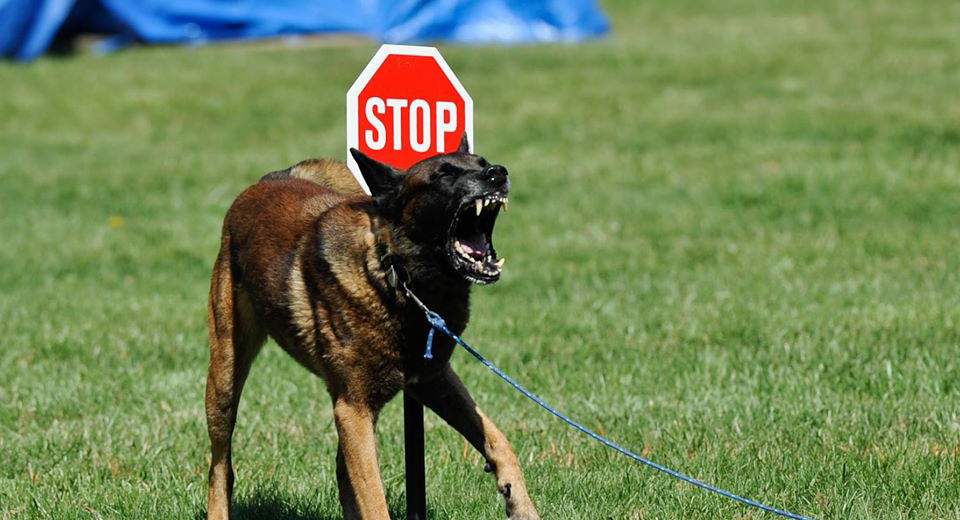
Aggression Full-Service Training
The Aggression Full Service Program focuses on dog and human aggression issues. There is a difference between aggression and the display of aggression. In some cases, the dog has often learned to display aggression because of mixed signals between the handler and the dog. During the initial evaluation, Carrie will determine and discuss the root of the aggression to advise you on the best training approach.
Our Aggression Program aims to create reliable obedience while defining boundaries and rules around your dog’s triggers. Your dog will be appropriately socialized or managed, coexisting around dogs and people to understand the rules of interaction. This program is a 3-week training program, and the focus is centered in numerous locations around town, which will provide your dog with plenty of other dog and people interactions.
It’s important to note that while our Aggression Full Service Program is comprehensive, it may only be suitable for some aggression cases. For instance, dogs that have been recently adopted or re-homed, dogs that predominantly display aggression in their home territory, and dogs that have bitten the owner or household members may not be the best fit for this program. We believe in transparency and want to ensure you have all the information you need to make the best decision for your dog.
All Full Service Programs include learning in the following 9 commands:
- Heel
- Automatic sit while heeling
- Sit
- Down
- Stay
- Door stays/car stays
- Come
- Place
- OK (the release command)
*For a detailed description of each command and the expectation please click here
Sit - In this exercise, the dogs behind must make contact with the floor. No hovering!
Down - In this exercise, the dog's elbows must touch the floor.
Heel - In this exercise, the dog should be in position on the left side (unless discussed otherwise during the meet/greet). Your dog's shoulder should line up with your knee, and the leash should be "loose" at all times.
Stay - In this exercise, you can leave the dog in a sit or a down position. The dog has to hold that position until you return to the dog and give the release. *You must never release the dog from the stay position if you are away from the dog. I want the dog to be clear about staying and coming. These two commands are opposite exercises. While in the stay, walk back to where you assigned the sit or down and give the release word "OK" to allow them to break the position.
Come - In this exercise, we wait until the dog is "free-roaming." Then, you say the dog's name and the COME command. The dog should stop what it's doing and come to you. The dog needs to be within a 1-yard radius of you and not leave until you give it the release command "OK."
Place - In this exercise, you assign your dog to a specific "Place." The definition of a place is anything that is elevated off the ground or has a texture difference. Examples are dog beds, Kuranda beds, park benches, and backseats of cars; you can be creative and challenge your dog! The same rules apply as in the stay position.
No - This command marks a behavior we want the dog to change.
Good - We tell our dogs this command to let them know they are doing what we want and that if they continue this behavior, they will be rewarded or eventually given the release command "OK."
OK - Release word to end any exercise.
Off - This command is used for jumping on people or furniture. If the dog's feet leave the ground, we will say NO OFF.
Out - To release a toy.
Enough - This is a command we use around the kennel for barking. If your dog is barking, Enough indicates you need the dog to stop.
Mannerisms your dog knows from the training without having to say a specific commands - Not bolting out of an opened door, not jumping out of the car when the door is opened, not rushing out of a crate when you open the door, sitting before meals, sitting to get their collar and leash put on, not jumping to great guests, not counter surfing/begging, not being overly pushy for attention. *All the unspoken behaviors that make a dog easier to live with!
*Click here to read more information about dog/human aggression
Dog on Dog Aggression:
It is very unnatural for a dog to lack the social skills at a young age to interact around other dogs. That doesn’t mean your dog will be best friends with every dog they encounter but having realistic goals and expectations that include:
- Maintaining reliable obedience in public around other dogs
- Walking on leash past other dogs on a sidewalk or street
- Taking a trip to your vet office or going to a pet store where dogs will be present
All these events can and should take place without your dog lunging, barking or acting out at the site of another dog.
If you are having any of these issues with your dog, you want to make sure you are not sending the dog mixed messages in your handling. The most common contributing factors towards your dog’s aggressive reaction towards other dogs are:
- Walking the other way when seeing a dog
- Restraining a dog while he/she is barking or lunging
- Distracting a dog by asking for “eye contact” or obedience commands
- Using treats to bribe a dog not to bark/lunge
- Using treats as a method to distract the dog
These approaches are incorrect and are unfortunately often suggested by other trainers. This method can cause more frustration, which you can see demonstrated by the seasoned reactive dog that has now created this response as their new job. The Doghouse, can help you understand the root of the issue and the proper training approach to take.
Human Aggression:
Having issues with your dog lunging/barking at people can be very unsettling. Many people get a dog for some sense of “protection”, but what draws the line between having a dog that alerts them of a stranger and having a potential liability occurrence? It is important to remember that all dogs are capable of growling, barking or biting and that all dogs are in full control of their mouths and what they decide to do with them.
Insecure dogs that have found a “false” sense of security by acting out aggressively towards our friends, neighbors, and/or the community are a liability and can become a potential danger.
In some cases, an overly confident dog has experimented with controlling people by using aggressive behaviors. Sometimes, these displays of challenging begin with a low grumble or lip curl over a high drive bone, their food bowl, space on furniture, and/or you attempting to groom them.
If these acts of aggression have started occurring in your household, possible outcomes are:
- Inability to have friends over
- Unable to take the dog to the vet without them being sedated or muzzled
- Members of the household becoming timid around the dog
- Having to wait to take your dog for a walk until no other dogs/people are present
- Restricting your dog to never leave their house/backyard
The Doghouse and their training team have had the privilege of rehabilitating thousands of aggressive dogs to be successful members of the community. Having trained Personal Protection Dogs and competing with our own dogs in protection sports, we understand the various drives within aggression and more importantly how to manage them.
The first step to rehabilitate your dog is to schedule a Behavior Analysis/Meet Greet at the training facility. With access to many different ages, breeds, temperaments, and personalities of dogs in a controlled setting, we can thoroughly evaluate your dog and advise on the best training approach




